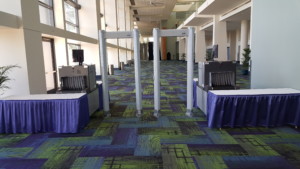by Charles Patterson
Protecting trade secrets and confidential information is key to the success of all corporations.
Recently, on May 11, 2016, a new bill introduced by Sen. Orrin Hatch, R-Utah and Sen. Chris Coons, D-Del., was signed into law by President Obama. This law is aimed at allowing businesses to sue in federal court for trade secret theft. Such lawsuits previously were left to state courts.
“As many of you know, one of the biggest advantages that we’ve got in this global economy is that we innovate. We come up with new services, new goods, new products, new technologies,” Obama said in signing the bill. “Unfortunately, all too often, some of our competitors, instead of competing with us fairly, are trying to steal these trade secrets from American companies. And that means a loss of American jobs, a loss of American markets, a loss of American leadership.”
Sen. Orrin Hatch, R-Utah, left, and Sen. Chris Coons, D-Del., center, listen as President Barack Obama speaks in the Oval Office of the White House in Washington, Wednesday, May 11, 2016, before signing the Defend Trade Secrets Act of 2016 (DTSA).
There are some dissenters expressing concern that the new law does not do enough to require identification of what intellectual property is actually considered a trade secret. This could lead to greater cost of defense in litigation if the defendant claims that they did not know the information was considered confidential. If you like reading legal jargon, a letter from 42 dissenting law professors can be found here.
Regardless of how one may consider the new law, the need to demonstrate the validity of a trade secret is necessary to create the foundation for legal action.
TSCM inspections and sweeps are an important step for establishing that conversations, and meetings are confidential, and that the information being discussed is a trade secret.
Some of the security steps to consider include the following:
- Full sweeps of the conference location prior to the meeting
- This would include radio spectrum analysis, thermal imaging, non-linear junction detection (electronic devices) and a full physical inspection of the area.
- Real time monitoring (live monitoring) of the radio spectrum
- This requires the room to be swept ahead of time, then the rf spectrum can be monitored during the event to insure no new transmitting devices are introduced.
- Prevent the admission of cell phones and laptops to the meeting or requiring them to be in airplane mode- no radio transmissions
- Any devices that may need to be allowed (if attendees may need laptops, for instance) can be required to be in airplane mode, have all wifi and bluetooth turned off, and then checked by radio analysis to insure that they are not transmitting.
- Use of magnetometers and xray machines for attendees
- This is a clear step that lets attendees know you consider the meeting highly confidential
- And the simple step of clearly posting a sign stating that the conversations and information being discussed is confidential and may not be repeated or shared.
- Often overlooked, posting a sign can help clarify for attendees the seriousness of the concerns.
Perry Mason and Detective Paul Drake took some extreme steps to protect a client in this clip from a 1965 TV show, x-raying every attendee- probably not recommended today!

Magnetometers, x-ray machines for bags and purses, and walk-through cell phone detectors are good methods for keeping many devices out of meetings, but they are not always practical and many new small devices are easily disguised and might be overlooked. A truly confidential meeting may require a very close inspection of all items brought in by attendees.
More Links:
[Read more on the history of the Defend Trade Secrets Act from IP Watchdog]
